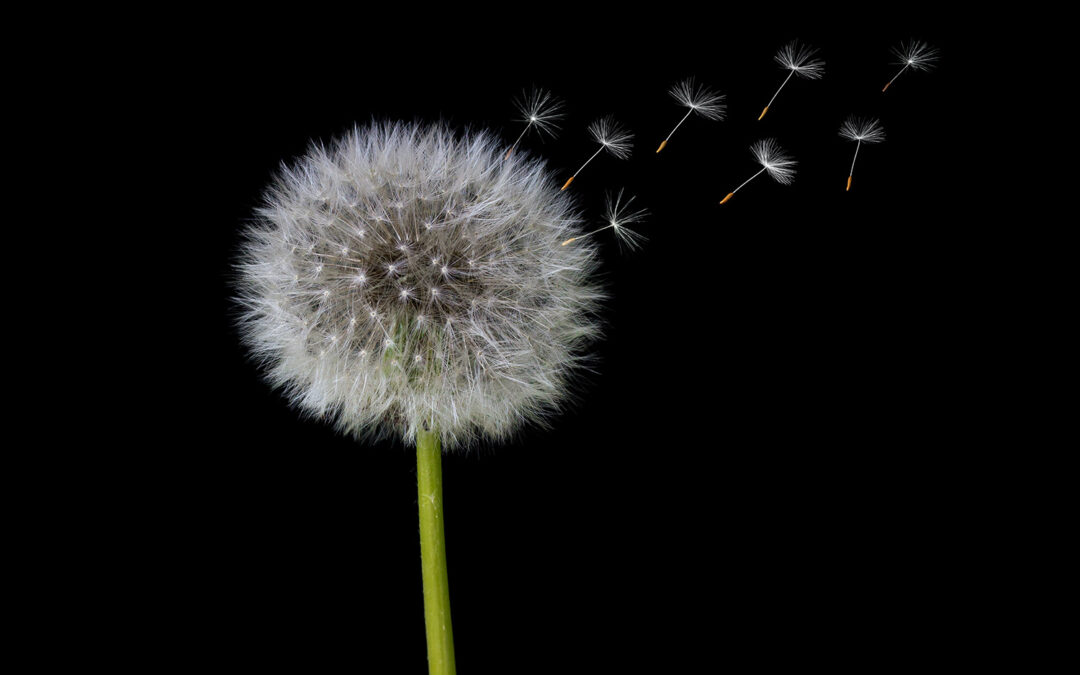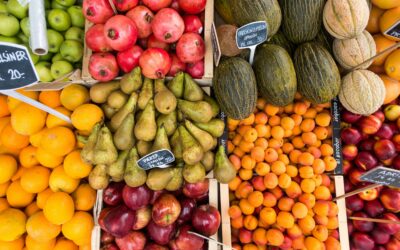The miraculous in the common
by Jennifer Grant
THE GROUNDSKEEPERS have just mowed the park. Walking across the meadow, I kick at thick, matted clumps of grass. Then I spy, a few feet ahead of me, a lone dandelion standing up straight. About six or seven inches tall, its puff of silver seeds is a perfect globe. I wonder how it remained untouched: Did it somehow duck down, protecting its mane, until the mower passed?
I bend down and pluck it, and its hollow stem makes a soft pop. I look at its seeds; they’re tiny parachutes waiting for release. I inhale deeply and then, like a child making a wish, release my breath and watch the seeds take flight.
SEEING DANDELIONS DIFFERENTLY
When my children were little, I discouraged them from blowing dandelion seeds. Instead, I paid them a nickel or dime for every yellow head they snapped off the plants in early spring. It was my inexpensive, eco-friendly attempt at weed control, and it worked fairly well. But I see dandelions differently now. If I could do it all over again, I’d invite my kids to blow the seeds like a million wishes into the breeze whenever they found a dandelion that had gone to seed.
All those years ago, I didn’t know that dandelions are a key food source for pollinators. Bees, butterflies, and moths—like the whimsically named “pearl-bordered fritillary,” named for the row of pearly markings along the underedges of its wings—love them. Songbirds including whitethroated sparrows, American goldfinches, and indigo buntings feast on dandelion seeds too.
As a young mother and new homeowner in a pristine suburb, I thought a lawn full of dandelions was cause for shame. Dandelions were noxious: unwelcome weeds and nothing more.
But it wasn’t always this way. Dandelions have been a key element in traditional Chinese medicine for millennia and were prized by ancient Egyptians, Romans, and Greeks in their pharmacies as well. Dandelions can be used to treat infections and to address other medical problems, like heartburn, constipation, and liver disorders. In Victorian England, they were considered a delicacy and servednin salads and sandwiches.
BRIMMING WITH BENEFITS
Dandelions came to North America with the English in the seventeenth century. They brought seeds from home and planted and tended the plants. The frugal Puritans loved them, as every part of the plant can be eaten—its root, stem, and flower. Rich in vitamins A, C, and K and high in calcium, iron, magnesium, and potassium, they’re nutritious too. Their yellow flowers are also used to make natural dyes. Dandelion flowers are still used to make wine, and some breweries today use the greens as a substitute for hops. No wonder that for so long, they were a fixture in kitchen gardens.
Before the nineteenth century in North America, land around both Indigenous peoples’ and colonists’ homes was used for vegetable and herb gardens and for animals to graze. Only after Thomas Jefferson created manicured gardens at Monticello did surrounding one’s home with a perfect, weedless lawn come into fashion in the dominant culture. Fast-forward to today, when Americans spend millions of dollars a year on lawn pesticides to maintain uniform lawns of nonnative grasses, using 30 percent of the country’s water supply to keep them lush and green.
So despite the good work the modest dandelion does for insects, people, and even other plants—their deep and sturdy taproots bring nutrients closer to the ground, helping nearby shallow-rooted plants—they have been banished from our properties.
EVERYDAY MIRACLES
After I blow the seeds away, I notice a drop of milky liquid on my hand. The sap that has spilled out of its stem is actually latex, containing natural rubber.
Something like twenty thousand species of plants produce latex, but only a fraction of these contain rubber in their sap. Rubber, of course, is ever in high demand for making tires, toys, medical devices, shoes, and so much more. The fact that rubber can be produced from dandelion milk once again points to the value of this unassuming plant. Scientists in Germany and Belgium have developed technologies to make natural rubber from dandelions that is the same quality as that produced from rubber trees. (The plants and animals whose ecosystems are threatened by rubber plantations thank the dandelion most wholeheartedly.)
Food. Medicine. Tea. Dye. Wine. Beer. Latex. As if all of those contributions weren’t enough, dandelions are also beautiful. Their yellow-orange flowers are actually made up of tiny individual flowers called “ray florets,” and the bloom opens at sunrise and closes at night. And although you might think it’s called dandelion because of that yellow mane, its name actually comes from the French dent de lion, meaning “tooth of the lion,” for the jagged shape of its leaves.
Dandelions grow fast, their roots are deep, and they can survive harsh conditions. These traits have led psychologists to develop new metaphors to describe mental and emotional resilience, naming highly sensitive individuals “orchids,” medium-sensitive people “tulips,” and yes, low-sensitive folks “dandelions.” Most of us, by the way, are tulips (40 percent), while 31 percent of us are orchids: individuals who are generally more sensitive or fragile, who do exceptionally well in ideal conditions and exceptionally badly in poor ones. About 29 percent of us are dandelions: resilient, generally less sensitive to the surrounding environment, and able to grow fairly well anywhere.
Walking up the driveway, back home again from the park, I look at the dandelion stem in my hand and wonder, How many times did I walk over one, fail to notice one, or otherwise miss the everyday miracle of this plant?
The dandelion is the only flower that represents three celestial bodies during different phases of its life cycle—sun, moon, and stars. The yellow flower of the plant resembles the sun. The puffball, when it has gone to seed, looks like the moon. And the dispersing seeds of the plant are like stars. It is a miracle.
In his essay “Nature,” Ralph Waldo Emerson describes the energy and joy human beings can derive from nature. He saw everything in the natural world as an “incarnation of God” and an “expositor of the divine mind.” [One sentence at the end of his essay] crystallizes the content of the entire work, the oft quoted words “The invariable mark of wisdom is to see the miraculous in the common.” Dandelions give us the opportunity to do just that.
Reprinted with permission from Dimming the Day: Evening Meditations for Quiet Wonder by Jennifer Grant copyright © 2021 Broadleaf Books.
Jennifer Grant is the award-winning author of picture books for children and books for adults. Grant is a founding member of INK: A Creative Collective and lives in Chicago with her husband and daughter.
Faithful eating
By Ryan Cumming THE QUESTION IN MY EMAIL inbox was one of the oddest I had received as a food systems educator: “How did a plastic box of Brussels sprouts destined for a grocery store in the northeastern U.S. end up on a discount table at a farmer’s market in the Bay...
Of monkeys, tears and the Wisdom of God
I was terrified. And I cried. I was living and working at the Lutheran Theological Seminary in Hong Kong at the time. I’m not weepy or alarmist by nature. I’d weathered a ginormous flying cockroach in my shower. Swatted it hard and disposed of it. I wasn’t crying...
What critters teach us about faith
God wants us to take care of our world. My young son Richard showed me that years ago when he found a wounded bird, a Robin, in our backyard. He named it “John”. Richard ran in and said we had to save him. His dad and I realized that this Robin was one of God’s...





